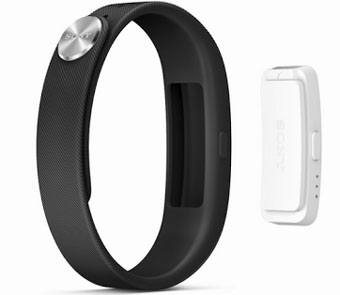
High Tech, You Can Wear
By R. Alan Clanton | Wednesday, January 8, 2014 |
Thursday Review editor
Get ready for the next big thing, or at the thing that the so-called technology experts envision as the next big thing: wearable tech gear and wearable apps.
Once considered exotic, to put it politely (some would say over-the-top tech eccentric), wearable technology is now approaching the market with the potential force of a retail tsunami. Wired magazine, usually as hip to the rapidly-evolving world of retail tech as any source, suggests in their latest cover story that wearable tech gear will be as big as the smart phone within a few years.
Just days ago Sony announced the release of its latest life-logging product, the Sony Smart Band, which users wear on their wrist. The band requires a small device called a Core, which is then used for tracking purposes, and the accumulated data can then be uploaded directly to the user’s smart phone or computer (see the image we've attached here, courtesy of Sony).
This week in Las Vegas, Nevada, at the annual International Consumer Electronics show, wearable electronic swag such as Sony’s new devices are all the rage, and may have supplanted, when it comes to expectations, all other forms of cutting-edge gadgetry combined. Many electronics experts and technology watchers think that the wearable gear will soon become as di rigeur as the ubiquitous cell phone.
These devices are plenty, and widely divergent in style and composition, but they all share the common goal of being small and light enough to be attached, embedded, implanted or strapped to the human body. These tools will also be able, very soon, to track everything you do, or every piece of data you choose for them to capture. This can include health-related applications such as heart rate, blood sugar levels, blood flow, respiration, and neurological data.
But these Dick Tracy-type implements may also be used for capturing and storing information—audio, video, real time activities, physical location, and even deeply personal data: how many times you brush your upper teeth as opposed to your lower teeth; calorie intake during meals; alcohol levels in the bloodstream; heart rate during sex; physiological and chemical reactions during encounters in grocery stores and malls; blood pressure during stressful or confrontational situations; eye-position during work hours or while watching a movie; even the number of times you grind your teeth during your waking hours.
Some of the devices already in widespread use include eyewear with tiny cameras embedded at the front corner of the frame near the lens. Other forms of eyewear include audio recording options as well.
Many of these new, lightweight devices come in the form of wristwatch type configurations. Samsung is offering something called “Galaxy Gear,” a watch-like device with options for a host of data-tracking applications. A company called Netatmo has developed “smart jewelry” able to capture and quantify, among other things, exposure to dangerous levels of ultraviolet radiation. Other companies have tiny strap-on devices designed to quantify, well, almost anything. Numerous manufacturers are already planning full-bore marketing campaigns on wearable tech between 2013 and 2014, and those companies include big names like Apple, Samsung, Sony and Nike, and Google plans to make its much-talked about smart glasses available within the next year. Some industry experts expect Google's smart glasses to sell briskly from the first moment they hit the stores next year.
Some readers may ask…well…why? Certainly in the age of Facebook and Twitter, such a question seems pointless. Is there anything that we still regard as truly private?
On the other hand, as some technologists point out, if you wore a tiny device which warned you ahead of time that your body had just absorbed as much alcohol as it should safely consume—say, at a party or at a bar—then your life may have been instantly improved, and made safer. And would not a small wrist-worn device be nifty if it could remind you of that boiling tea kettle on the stove, or warn you that you left the back door unlocked before you drive to the airport to go on a business trip? Would a tiny wristwatch type tracking device be useful for a family with a member of the household who is severely asthmatic or diabetic, or someone suffering from Alzheimer’s disease? Or any combination of the above?
The manufacturers of such technology hope that consumers will see the obvious advantages of such devices. In the meantime, those concerned with the collateral issue of privacy (gee, will the NSA have access eventually to all of this data, too?) will have to console themselves that the devices are, for now, somewhat pricey.
But costs will come down, as they always do once a technology has taken hold in the public’s mind.
